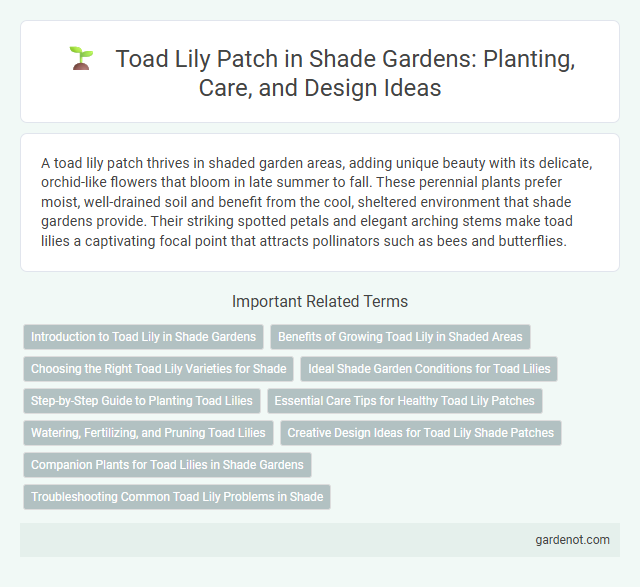A toad lily patch thrives in shaded garden areas, adding unique beauty with its delicate, orchid-like flowers that bloom in late summer to fall. These perennial plants prefer moist, well-drained soil and benefit from the cool, sheltered environment that shade gardens provide. Their striking spotted petals and elegant arching stems make toad lilies a captivating focal point that attracts pollinators such as bees and butterflies.
Introduction to Toad Lily in Shade Gardens
Toad lilies (Tricyrtis spp.) are shade-loving perennials prized for their unique, orchid-like flowers that bloom in late summer to fall. These plants thrive in moist, well-drained soils with dappled sunlight, making them ideal for understory garden beds and shaded borders. Their speckled, star-shaped blossoms add striking texture and color to shade gardens, attracting pollinators such as bees and butterflies.
Benefits of Growing Toad Lily in Shaded Areas
Toad lilies (Tricyrtis spp.) thrive in shaded gardens, offering unique late-season blooms that brighten dim areas when most other plants have ceased flowering. Their shade tolerance reduces competition for sunlight, making them ideal for under-tree or woodland garden settings, while their butterfly-attracting flowers support local pollinators. Growing toad lilies in shaded areas also helps with moisture retention in soil, promoting healthier plant growth and reducing the need for frequent watering.
Choosing the Right Toad Lily Varieties for Shade
Selecting the right toad lily varieties for a shade garden enhances bloom vibrancy and plant health, with popular cultivars like Toad Lily 'Dark Horse' and 'Autumn Pastel' thriving in low-light conditions. These varieties prefer moist, well-drained soil rich in organic matter, ensuring optimal growth under dappled or partial shade. Incorporating a mix of species such as Tricyrtis hirta and Tricyrtis formosana offers diverse flower shapes and colors, creating a striking toad lily patch that brightens shady garden areas.
Ideal Shade Garden Conditions for Toad Lilies
Toad lilies thrive in a shade garden with well-drained, humus-rich soil that retains moisture without becoming soggy. These perennial plants prefer partial to full shade, mimicking their natural woodland habitat, and consistent humidity for optimal growth and vibrant blooms. Ensuring protection from harsh afternoon sun and strong winds supports healthy development and prolongs the delicate flowering season.
Step-by-Step Guide to Planting Toad Lilies
Choose a shaded, well-drained location rich in organic matter to plant toad lilies, ensuring they receive morning sun or dappled light for optimal growth. Prepare the soil by loosening it to a depth of 12 inches and incorporating compost to enhance moisture retention and fertility. Plant rhizomes 12 to 15 inches apart, cover with soil, water thoroughly, and mulch to maintain consistent moisture and protect roots during winter.
Essential Care Tips for Healthy Toad Lily Patches
Toad lily patches thrive in consistently moist, well-drained soil enriched with organic matter, ensuring a shady environment to mimic their natural woodland habitat. Regular watering during dry spells and applying a balanced, slow-release fertilizer in early spring supports vigorous growth and vibrant blooms. Mulching with leaf litter or compost helps maintain soil moisture, suppress weeds, and protect roots from temperature fluctuations.
Watering, Fertilizing, and Pruning Toad Lilies
Toad lily patches thrive in consistently moist, well-drained soil, requiring regular watering to maintain hydration without waterlogging. Fertilize with a balanced, slow-release fertilizer in early spring to promote lush growth and vibrant blooms throughout the season. Prune spent flowers and yellowing leaves promptly to encourage continuous blooming and prevent disease, ensuring a healthy, vigorous plant in shade gardens.
Creative Design Ideas for Toad Lily Shade Patches
Toad lily shade patches thrive in moist, well-drained soil with dappled sunlight, making them ideal for woodland-inspired garden corners. Incorporate a mixture of textured foliage plants like ferns and hostas to enhance visual contrast and highlight the toad lily's unique spotted blooms. Layering varying heights within the shade garden adds depth and emphasizes the delicate, late-season flowers of toad lilies, creating an enchanting and dynamic undergrowth display.
Companion Plants for Toad Lilies in Shade Gardens
Companion plants for toad lilies in shade gardens include ferns, hostas, and astilbes, which thrive in similar low-light, moist conditions. These plants enhance the visual appeal by providing contrasting textures and foliage while supporting the humidity and soil environment preferred by toad lilies. Incorporating woodland phlox and bleeding hearts can further enrich biodiversity and attract pollinators to the shaded garden area.
Troubleshooting Common Toad Lily Problems in Shade
Toad lily patches in shade gardens may face issues like fungal leaf spot, which causes brown or black lesions on leaves due to excessive moisture. Ensuring good air circulation and avoiding overhead watering reduces fungal infections and promotes healthier growth. Slugs and snails often damage toad lily foliage, so applying organic slug deterrents or using barriers can protect the plants effectively.
Toad lily patch Infographic

 gardenot.com
gardenot.com